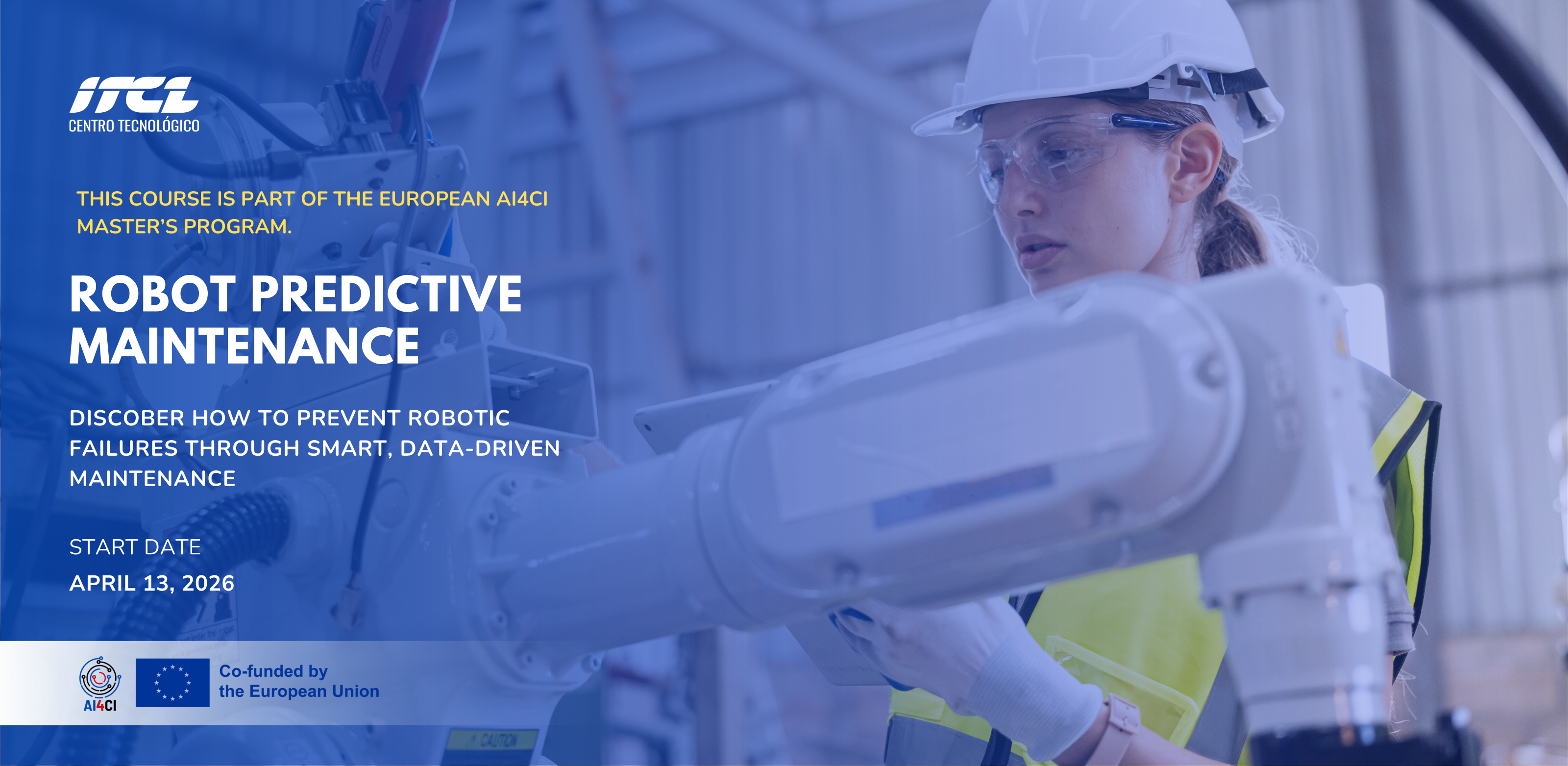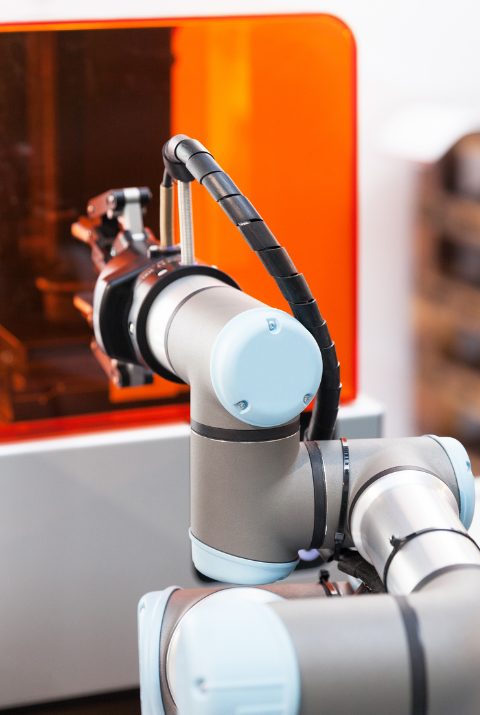ROBOT PREDICTIVE MAINTENANCE

ROBOT PREDICTIVE MAINTENANCE
COURSE DATES:
13 – 17 April 2025
TEACHING VOLUME:
Lessons: 15 hours
Supervised lab: 15 hours
Project: 45 hours
MODALITIES :
On line and presential
WHAT YOU'LL LEARN
Discover how to prevent robotic failures using predictive maintenance techniques, real-time data analysis, and hands-on tools. Learn to detect anomalies, plan maintenance actions, and work with both commercial and open-source robotic platforms
PREREQUISITES:
-
Basic Programming Knowledge: Many advanced robotics courses assume that students have solid programming knowledge.
-
Electronics Fundamentals: Understanding basic electronics concepts such as resistance, voltage, current, and having experience with common electronic components could be essential for working with robotic hardware
PEDAGOGICAL OBJECTIVES:
The goal of this STC is to teach you the basics of robotic typologies and operations, and how to perform and predict maintenance tasks on robots’ main constituent elements. This knowledge will enable you to define and implement a preventive maintenance plan for a robot, based on empirical tests and the manufacturer’s specifications. In this STC, you’ll learn the fundamentals of identifying and visualizing anomalies and failures in data provided by robot components. You’ll learn how to map these anomalies to failure conditions, enabling you to perform predictive maintenance to manage failures and avoid costly downtimes. The course includes learning about the electrical motor elements that comprise an articulated robot and understanding their operation and function. You’ll study the basic elements required to process and understand data obtained from the robot’s internals for predictive maintenance purposes. Additionally, you’ll learn how to carry out error diagnosis based on the robot’s operation log and how to prevent accidents during the maintenance of robotic equipment.
CORE CONTENT:
Carry out maintenance tasks on its main constituent elements, in order to define a preventive maintenance plan with a robot according to the empirical test and the manufacturer’s specifications. Know the main predictive maintenance tools]
- Morphological Foundations in Robotics: Types of Robots, Movement Control Systems, and Approaches to Access Maintenance Information of Main Constituent Elements
This section introduces the principal types of robots, focusing on the components most susceptible to failure in Industry 4.0 environments. You will gain an overall understanding of how these robots can be controlled and accessed. We will discuss the differences between commercial-brand robotics and open-source robotics, exploring how each solution allows us to access and analyze maintenance data from the robot’s main components.
- Mathematical and Programming Fundamentals of Robotic Programming
This section covers the practical and mathematical fundamentals of robot programming and calibration. It will explore the main programming paradigms used in the industry, including those employed by companies like ABB and open-source robotics platforms such as ROS. This section will include multiple references to the practical components of the modules.
3.Basic Robotic Sensors: Definition, Calibration, Potential Problems, and Maintenance
Sensors are a fundamental part of any robotic platform; most robots would not be able to operate without them. In this session, we will cover the foundations of the most important robotic sensors, how to calibrate them, the main problems that can occur with these devices and how to fix them, and good practices. The covered sensors are 2D cameras, 3D cameras, LIDAR, IMU, Radar, and wheel/motor encoders. We will also cover some use cases of these sensors to gain a deeper understanding of their use and discuss real situations where they failed and the problems such failures led to.
- Preventive and Predictive Maintenance: Tools to Forecast Incidents and Create Maintenance Programs (Part 1)
In this section, we will cover the basics of data analytics using methods like regression, time series analysis, and anomaly detection to predict potential failures in robot components. We will utilize data provided by the log systems of robots, both commercial and open-source. In addition, we will cover basic visualization tools that can help us better understand failures occurring in the main components of a robot.
- Preventive and Predictive Maintenance: Tools to Forecast Incidents and Create Maintenance Programs (Part 2)
SUPERVISED LAB:
ROS for Robotics Control and Monitoring
The Robot Operating System (ROS) is an operating system used to control, gather information, command, and synchronize different types of robotic platforms while utilizing open-source libraries. There are many different platform ecosystems to control robots, many of which are exclusive to a specific robotic platform. However, ROS is an open-source platform that benefits from a community developing on it, and most new robotic platforms are adopting it, especially with the new ROS2 suite. In this supervised lab, we will learn the basics of ROS, how to use different robotic platforms on ROS such as wheeled robots, quadrupedal robots, and robotic arms with their sensors; how to create a robotic simulation compatible with ROS; and how to visualize and gather data from such simulations so we can perform predictive maintenance or conduct maintenance studies with the data. The lab contemplates some use cases and examples with real robots at ITCL. The sessions will be:
- Basics of ROS to Control Robotic Platforms: First steps to control different types of robots on ROS in a virtual scenario.
- Basics of Gazebo Robotic Simulators: How to create robotic visual simulations and save the data for analysis. We will simulate a robotic arm and a wheeled robot.
- Examples of Sensor Calibration in ROS and Without ROS.
- Data Visualizations in ROS and Predictive Models Based on the Gathered Data.
- In-Depth Control of Robotic Arms and Wheeled Robots: Libraries to move robots.
- Analysis of Robotics Data with Jupyter Notebooks.
- Project: Simulate a use-case environment, analyze and find potential maintenance problems.
- Visualize Real Robot Data (to assess depending on the feasibility of doing it in person or remotely).
COMPLEMENTARY CONTENT:
Know the electrical-motor elements that comprise an articulated robot and understand its operation and function.
Know the control elements that direct and manage a robot, understand its operation and learn the basic notions of operation.
Learn to carry out an error diagnosis based on the robot’s operation log.
Acquire the necessary knowledge to prevent accidents during the maintenance of robotic equipment.
-
- Electronic composition of an articulated robot, access and maintenance of main constituent elements.
- Introduction to communication and control systems. Hierarchies and dependencies with peripheral systems.
- Security systems and devices in automated facilities.
- Adjustment and parameterization operations. PID control
- Verification and quality control of the operation.

